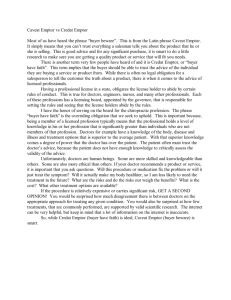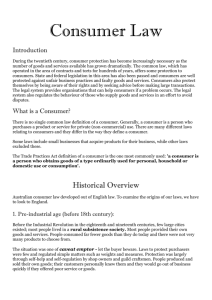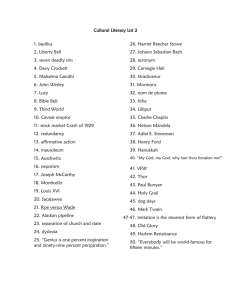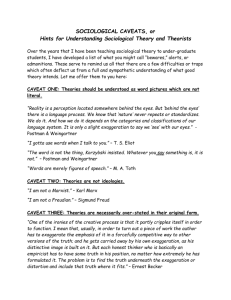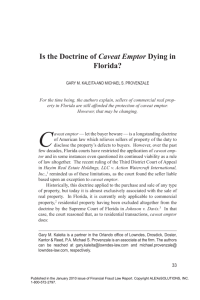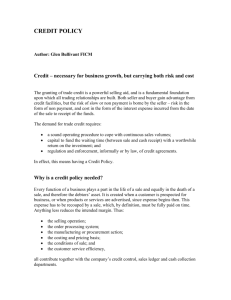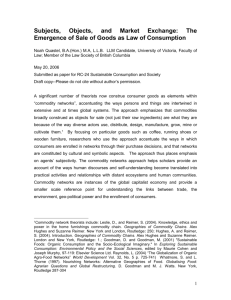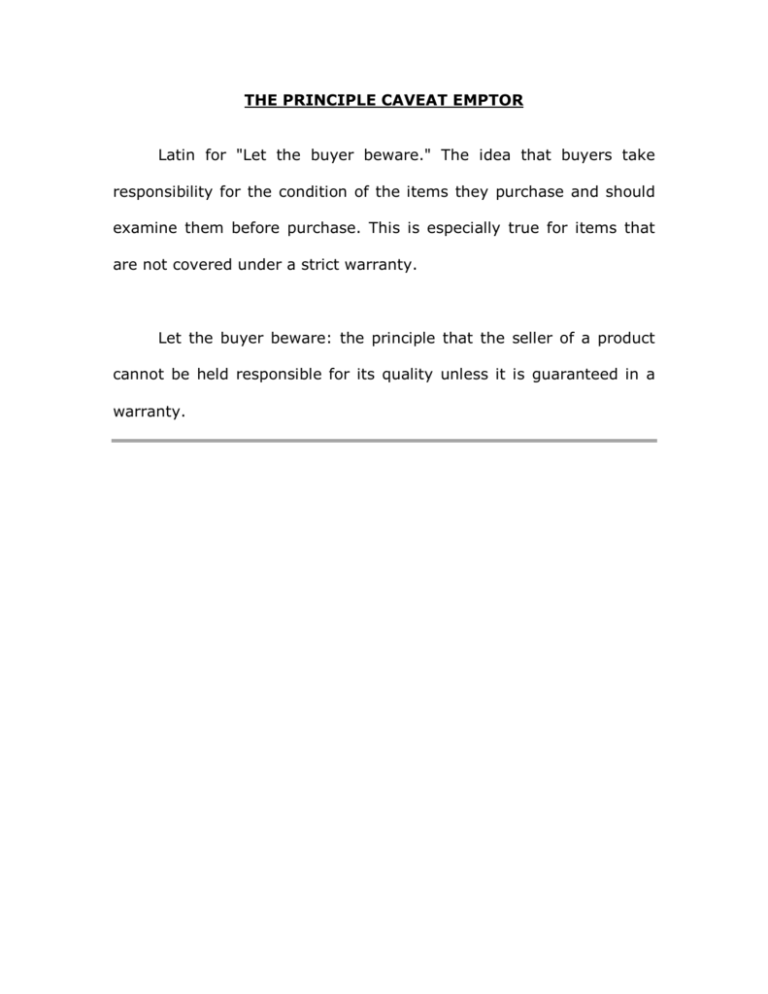
THE PRINCIPLE CAVEAT EMPTOR
Latin for "Let the buyer beware." The idea that buyers take
responsibility for the condition of the items they purchase and should
examine them before purchase. This is especially true for items that
are not covered under a strict warranty.
Let the buyer beware: the principle that the seller of a product
cannot be held responsible for its quality unless it is guaranteed in a
warranty.
CAVEAT EMPTOR
A warning that notifies a buyer that the goods he or she is
buying are "as is," or subject to all defects.
When a sale is subject to this warning the purchaser assumes
the risk that the product might be either defective or unsuitable to his
or her needs.
This rule is not designed to shield sellers who engage in Fraud or
bad faith dealing by making false or misleading representations about
the quality or condition of a particular product. It merely summarizes
the concept that a purchaser must examine, judge, and test a product
considered for purchase himself or herself.
The modern trend in laws protecting consumers, however, has
minimized the importance of this rule. Although the buyer is still
required to make a reasonable inspection of goods upon purchase,
increased responsibilities have been placed upon the seller, and the
doctrine of caveat venditor (Latin for "let the seller beware") has
become more prevalent. Generally, there is a legal presumption that a
seller makes certain warranties unless the buyer and the seller agree
otherwise.
One
such
Warranty
is
the
Implied
Warranty
of
merchantability. If a person buys soap, for example, there is an
implied warranty that it will clean; if a person buys skis, there is an
implied warranty that they will be safe to use on the slopes.
A seller who is in the business of regularly selling a particular type of
goods has still greater responsibilities in dealing with an average
customer. A person purchasing antiques from an antique dealer, or
jewelry from a jeweler, is justified in his or her reliance on the
expertise of the seller.
If both the buyer and the seller are negotiating from equal
bargaining positions, however, the doctrine of caveat emptor would
apply.
Cross-references
Consumer Protection; Sales Law.
West's Encyclopedia of American Law, edition 2. Copyright 2008 The
Gale Group, Inc. All rights reserved.
Caveat emptor (kah-vee-ott emptor) Latin for "let the buyer
beware." The basic premise that the buyer buys at his/her own risk
and therefore should examine and test a product himself/herself for
obvious defects and imperfections. Caveat emptor still applies even if
the purchase is "as is" or when a defect is obvious upon reasonable
inspection before purchase. Since implied warranties (assumed quality
of goods) and consumer protections have come upon the legal
landscape, the seller is held to a higher standard of disclosure than
"buyer beware" and has responsibility for defects which could not be
noted by casual inspection.
CAVEAT EMPTOR
Under the doctrine of caveat emptor, the buyer could not
recover from the seller for defects on the property that rendered the
property unfit for ordinary purposes. The only exception was if the
seller actively concealed latent defects. The modern trend in the US,
however, is one of the Implied Warranty of Fitness that applies only to
the sale of new residential housing by a builder-seller and the rule of
Caveat Emptor applies to all other sale situations (i.e. homeowner to
buyer). [See Stambovsky v. Ackley, 572 N.Y.S.2d 672 (N.Y. App.
1991)] Many other jurisdictions have provisions similar to this.
Before statutory law, the buyer had no warranty of the quality of
goods. In many jurisdictions, the law now requires that goods must be
of "merchantable quality". However, this implied warranty can be
difficult to enforce, and may not apply to all products. Hence, buyers
are still advised to be cautious.
In addition to the quality of the merchandise, this phrase also
applies to the return policy. In most jurisdictions, there is no legal
requirement for the vendor to provide a refund or exchange. In many
cases, the vendor will not provide a refund but will provide a credit. In
the case of software, movies and other copyrighted material many
vendors will only do a direct exchange for another copy of the exact
same title. Most stores require proof of purchase and impose time
limits on exchanges or refunds. However, some larger chain stores will
do exchanges or refunds at any time with or without proof of
purchase- although they usually require a form of picture ID and place
quantity or dollar limitations on such returns.
Laidlaw v. Organ, a decision written in 1817 by Chief Justice
John Marshall, is believed by scholars to have been the first U.S.
Supreme Court case which laid down the rule of caveat emptor in U.S.
law.[2]
In the UK, consumer law has moved away from the caveat
emptor model, with laws passed that have enhanced consumer rights
and allow greater leeway to return goods that do not meet legal
standards of acceptance.[3] Many companies operating in the UK will
allow customers to return goods within a specified period for a full
refund, even if there is no problem with the product.
CAVEAT EMPTOR
Caveat emptor is Latin for "Let the buyer beware". Generally caveat
emptor is the property law doctrine that controls the sale of real
property after the date of closing.
Explanation
Under the doctrine of caveat emptor, the buyer could not
recover from the seller for defects on the property that rendered the
property unfit for ordinary purposes. The only exception was if the
seller actively concealed latent defects. The modern trend in the US,
however, is one of the Implied Warranty of Fitness that applies only to
the sale of new residential housing by a builder-seller and the rule of
Caveat Emptor applies to all other sale situations (i.e. homeowner to
buyer). (See Stambovsky v. Ackley, 572 N.Y.S.2d 672 (N.Y. App.
1991) Many other jurisdictions have provisions similar to this.
Before statutory law, the buyer had no warranty of the quality of
goods. In many jurisdictions, the law now requires that goods must be
of "merchantable quality". However, this implied warranty can be
difficult to enforce, and may not apply to all products. Hence, buyers
are still advised to be cautious.
In addition to the quality of the merchandise, this phrase also
applies to the return policy. In most jurisdictions, there is no legal
requirement for the vendor to provide a refund or exchange. In many
cases, the vendor will not provide a refund but will provide a credit. In
the case of software, movies and other copyrighted material many
vendors will only do a direct exchange for another copy of the exact
same title. Most stores require proof of purchase and impose time
limits on exchanges or refunds. However, some larger chain stores will
do exchanges or refunds at any time with or without proof of
purchase- although they usually require a form of picture ID and place
quantity and/or dollar limitations on such returns.
Laidlaw v. Organ, a decision written in 1817 by Chief Justice
John Marshall, is believed by scholars to have been the first U.S.
Supreme Court case which laid down the rule of caveat emptor in U.S.
law.
This phrase has given rise to many informal variations, such as
caveat reader (properly expressed in Latin as caveat lector).
Caveat emptor has also been used by software documentors to
entitle their collection of software functioning oddities or stumbling
blocks in usage.
In the late 1960s, Gary Null was the editor of one of the nation's
first consumer health activist publications, called Caveat Emptor,
which was in print for over ten years.
CAVEAT VENDITOR
Caveat venditor is Latin for "let the seller beware". It is a
counter to caveat emptor, and suggests that sellers too can be
deceived in a market transaction. This forces the seller to take
responsibility for the product, and discourages sellers from selling
products of unreasonable quality.
In the landmark case of MacPherson v. Buick Motor Co. (1916),
New York Court Appeals Judge Benjamin N. Cardozo established that
privity of duty is no longer required in regards to a lawsuit for product
liability against the seller. This case is predominantly regarded as the
origin of caveat venditor as it pertains to modern tort law in US.

